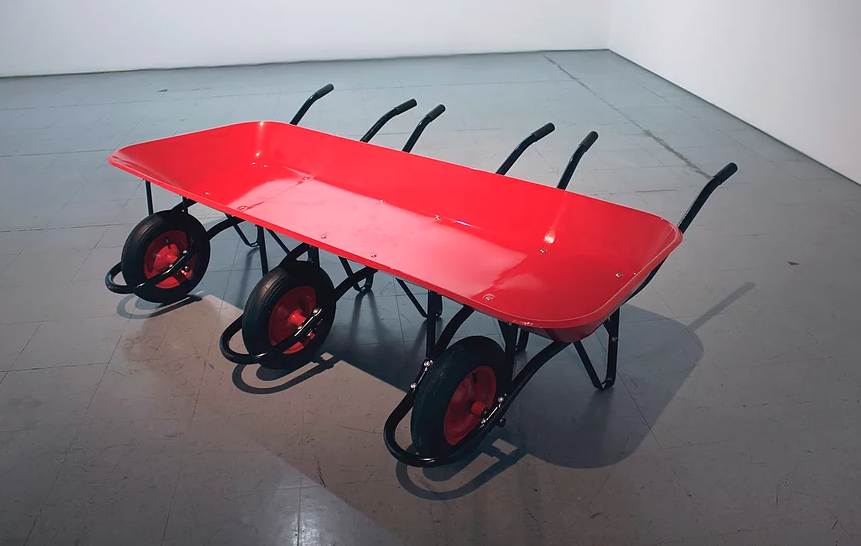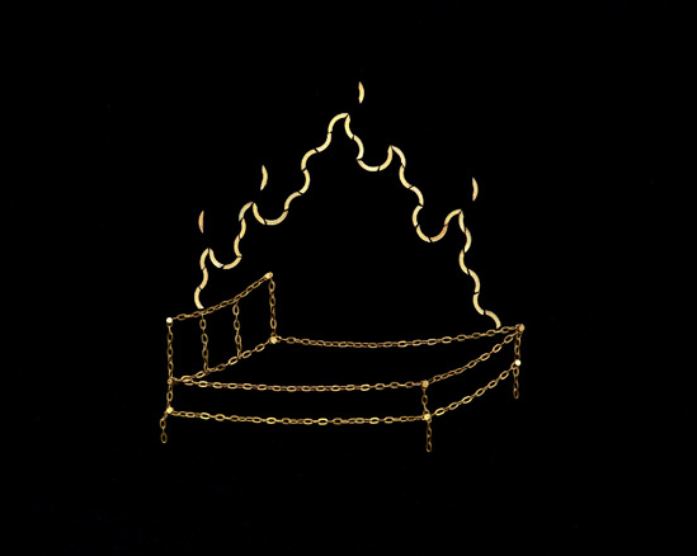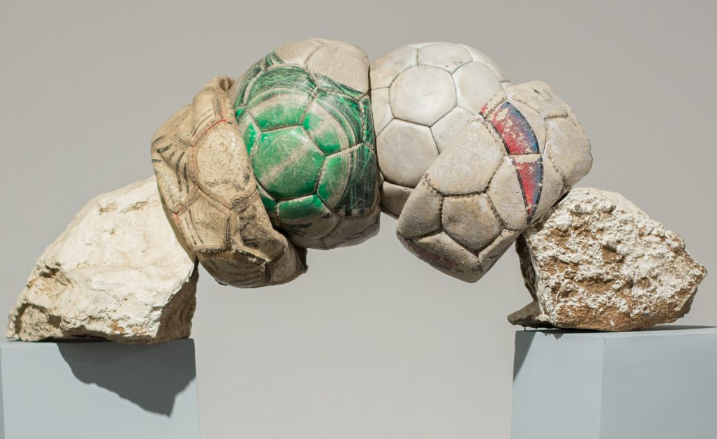Between the social, the object and the individual, 10 Chilean artists under 45, a list by Luisa Fernanda Lindo.
1. CAMILA RAMIREZ GAJARDO (1988)
Child’s play and its rules will be a fundamental part of her proposal, composed of drawings, installations, performances and impossible objects that put into question the utopia on which certain ideologies are sustained. Thus, through the reconstruction of social imaginaries, she generates a sharp critique of the capitalist system and suggests a new interpretation of the concept of ‘the communal’ and the education of the masses.
El juego infantil y sus reglas será una parte fundamental dentro de su propuesta, compuesta por dibujos, instalaciones, performances y objetos imposibles que ponen en cuestión la utopía sobre la que se sostienen ciertas ideologías. Así, a través de la reconstrucción de imaginarios sociales genera una aguda crítica al sistema capitalista y plantea una nueva lectura del concepto de ‘lo comunitario’ y la educación de masas.
 Carretilla comunitaria, 2012, imagen tomada de arteinformado.
Carretilla comunitaria, 2012, imagen tomada de arteinformado.
2. CATALINA GONZÁLEZ (1979)
Her work addresses the landscape from the resulting tension of the intervention and transformation of territory in the hands of power. Thus, through photography and other forms of media, she constructs spaces that invite reflection about history, memory, and social space, as a way of poetically resisting the perpetual violence on the landscape by the extractivist industry.
Su obra aborda el paisaje desde la tensión resultante de la intervención y transformación del territorio en manos del poder. Así, a través de la fotografía y otros medios construye espacios que invitan a reflexionar acerca de la historia, la memoria y el espacio social, como una forma de resistir poéticamente la violencia perpetuada al paisaje por la industria extractivista.
 Imagen: Serie Pampa Negra, 2016, imagen tomada del artista.
Imagen: Serie Pampa Negra, 2016, imagen tomada del artista.
3. ADOLFO BIMER (1985)
Bimer focuses on a material and metaphorical interiority of the human body. He inquires about how the medical imaging systems represent the human body and how this has an impact on the social image we have of ourselves. Movements, fluids, organs and body textures are contrasted to industrial and construction materials that he intervenes and manipulates through painting, sculpture and installation.
Bimer se centra en una interioridad material y metafórica del cuerpo humano. Así, indaga acerca de cómo los sistemas médicos de producción de imagen representan el cuerpo humano y cómo esto incide en la imagen social que tenemos de nosotros mismos. Movimientos, fluidos, órganos y texturas del cuerpo son contrapuestos a materiales industriales y de construcción que interviene y manipula por medio de la pintura, la escultura y la instalación.

292: Línea de sangre, 2018, imagen tomada del artista.
4. NICOLÁS GRUM (1977)
Humor, critique and irony are manifested through Grum’s work, who conceives reality as a space which makes sense through manipulation, editing, deception and strength. Through videos, drawings, sculptures and installations, he subverts the signs and symbols of power, putting the idea of authority and the notions of truth, credibility or correctness into crisis.
El humor, la crítica y la ironía se manifiestan en la obra de Grum, quien concibe la realidad como un espacio que cobra sentido mediante la manipulación, la edición, el engaño y la fuerza. A través de videos, dibujos, esculturas e instalaciones, subvierte los signos y símbolos del poder, poniendo en crisis la idea de autoridad y las nociones de verdadero, verosímil o cierto.
 Imagen: Obras no recientes, 2017, imagen tomada del artista.
Imagen: Obras no recientes, 2017, imagen tomada del artista.
5. MIGUEL SOTO KARELOVIC (1990)
Soto conceives landscape as a narrative space, a textuality that focuses on collective and local imaginaries as products of colonization and cultural appropriation. In this way, he explores the changes that objects and images undergo when they are geographically transferred as a kind of familiar and autobiographical metaphor; therefore, his works are exhibited as objects that are displaced or dissociated from their context.
Soto concibe el paisaje como un espacio narrativo, una textualidad que se centra en imaginarios colectivos y locales producto de la colonización y la apropiación cultural. De esta manera, explora los cambios que experimentan los objetos e imágenes al ser trasladados geográficamente como una suerte de metáfora familiar y autobiográfica; por ello, sus obras se exhiben como objetos desplazados o disociados de su contexto.
 Semiprecioso, 2018, imagen tomada del artista.
Semiprecioso, 2018, imagen tomada del artista.
6. RODRIGO VALENZUELA (1982)
Displacement and alienation, the themes that govern his work, present themselves not only in relation to space, but also time. Therefore, his installations have the capacity to produce a stranger in the spectator, to the extent that those objects that are familiar to us are presented as strangers. Thus, his work as a whole produces a sensation of nostalgia for a future in ruins.
El desplazamiento y la alienación, que son los temas que rigen su obra, se presentan no solo en relación al espacio sino también al tiempo. Por ello, sus instalaciones tienen la capacidad de producir un extrañamiento en el espectador, en la medida en que aquellos objetos que nos son familiares se presentan como desconocidos. Así, su obra en conjunto produce una sensación de nostalgia de un futuro en ruinas.
 Prole, 2015, imagen tomada del artista.
Prole, 2015, imagen tomada del artista.
7. CATALINA BAUER (1976)
The exploration of the materials and their potential to be manipulated by ones hands is what characterizes the work of Bauer. Therefore, having fabric as the matrix of her artistic production, she turns to drawing and sculpture. Thus the individual and the collective intertwine in a collaborative process that constitutes the very meaning of her work.
La exploración de los materiales y su potencial de ser manipulado con las manos es lo que caracteriza la obra de Bauer. Por ello, teniendo al tejido como matriz de su producción artística, recurre al dibujo y a la escultura. Así lo individual y lo colectivo se entrelazan en un proceso colaborativo que constituye el sentido mismo de su obra.
 De la serie Ofrecer la resistencia, 2018. Imagen tomada de la galería.
De la serie Ofrecer la resistencia, 2018. Imagen tomada de la galería.
8. SEBASTIÁN MAQUEIRA (1978)
Maquiera’s work explores the symbology of everyday objects and their capacity to produce meanings that can be enough to determine the identity and worldview of both individuals and societies. Thus, from the collection, selection and assembly of diverse objects, he produces assemblies where the represented image initiates a dialogue with the same elements that make it up.
La obra de Maqueira explora la simbología de los objetos de la vida cotidiana y su capacidad de producir significados que pueden llegar a determinar la identidad y cosmovisión tanto de los individuos como de las sociedades. Así, a partir de recolección, selección y ensamblaje de objetos diversos, produce montajes donde la imagen representada entabla un diálogo con los mismos elementos que la conforman.
 Imagen: Cama en llamas 1, 2014, tomada del artista.
Imagen: Cama en llamas 1, 2014, tomada del artista.
9. DIEGO SANTA MARÍA (1982)
The link between the landscape and territories is imminent in Santa María’s artistic production. Therefore, his work articulates the everyday, wear and tear, emptiness, and history through compositions made with collected objects and paintings that, through their materiality, try to reproduce the deterioration caused by the passage of time, while they put the constructed imaginary around the landscape in tension.
El vínculo con el paisaje y los territorios es inminente en su producción artística. Por ello, su trabajo articula lo cotidiano, el desgaste, el vacío y la historia, a través de composiciones realizadas con objetos recolectados y pinturas que, por medio de su materialidad, intentan reproducir el deterioro causado por el paso del tiempo a la vez que ponen en tensión la imaginería construida alrededor del paisaje.
 Cordillera de la costa IV, 2016, de exposición Borde costero en @galerianac Imagen tomada del artista.
Cordillera de la costa IV, 2016, de exposición Borde costero en @galerianac Imagen tomada del artista.
10. SOFÍA DE GRENADE (1983)
The ecological and social impact that industrialization and extractivism have on the territory are the center of her artistic practice. Making use of industrial materials, she considers ways to make visible the permanence of the inorganic in the territory, while reflecting on the exploitation, privatization, theft of natural resources and durability of industry wastes that undermine the idea of progress.
El impacto ecológico y social que tienen en el territorio la industrialización y el extractivismo, son el centro de su práctica artística. Valiéndose de materiales industriales se plantea formas de hacer visible la permanencia de lo inorgánico en el territorio, a la vez que reflexiona acerca de la explotación, la privatización, el robo de recursos naturales y la perdurabilidad de los desechos de la industria que atentan contra la idea del progreso.
 Leer un rayo, 2018, imagen tomada de Terrmoto, cortesía de la Galería Patricia Ready.
Leer un rayo, 2018, imagen tomada de Terrmoto, cortesía de la Galería Patricia Ready.
*Text and selection by Luisa Fernanda Lindo, artist and curator
*Translation by Samantha Bay and Neta Kanny
*Edited by Paul Alonso
















































































































